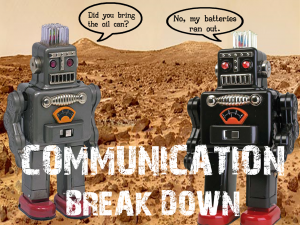Ever felt you were speaking to a colleague or client and not getting very far? Felt like you could be on another planet? All too often we suffer communication breakdown. Well, the fabulous Andy Bounds, author of one of my favourite books, The Jelly Effect has identified Top Ten things to avoid a communication breakdown.
- Back-to-back meetings. When there are no breaks in between, when exactly are people supposed to prepare or follow-up? I guess there are only two answers: ‘at home’ or ‘never’
- Pointless communications. You know all those comms – all those reports, meetings, conference calls, emails – that achieve nothing? The ones that nobody would mind if they stopped?
- Too irrelevant. Sometimes, unlike the previous point, you do need to have a certain communication. But even these can contain content you just don’t need – pointless agenda items, unnecessary chapters, too many background slides..
- Too boring. Ever attended a conference call that was tedious? A meeting that dragged on and you wish you were on the bus home? Presentations where the presenter read their wordy slides to you?
- Too long. Preparation isn’t finished when your communication is as thorough and long as possible. It’s finished when it’s as short as possible
- Too selfish. You know the type of thing… ‘Here’s my content, with all the detail I care about. My time is so important that I haven’t had time to remove the slides you don’t need. And now I need you to do X. And I mean right now’
- Wrong channels. People often email when they should chat. They hold big meetings to discuss topics that should have been done face to face.
- Wrong person. When Person A wants to impact Person B, they should speak to her directly. Asking Person C to act as a middle-man is rarely as good. It dilutes A’s passion and clarity; plus, B’s questions are rarely answered as well/at all (We’ve all known for years that this doesn’t work – remember the teenage years of a middle man saying ‘my mate fancies you’? Not good)
- Poor cascades. One exception to the previous point: middle-men can be good for cascading info from on high. But only when the middle-man adds something to the message – their own experiences, personalising it for his team etc. If he adds nothing, he serves minimal purpose in the chain. In fact, he can make things worse if he does something as dismissive as “FYI – read this”
- Onerous pre-reads. Giving people too much to read for a meeting is… well, too much. The pre-reads are supposed to enable decisions, not be a rant about everything – background, the work done so far, rationale, etc.
Fortunately, the solutions are simple:
- Back-to-back meetings – stop having them. Finish at 10.45, not 11.
- Pointless communication – stop creating yours. Stop reading others.
- Too irrelevant – when preparing, ask people ‘what content do you want me to include?’
- Too boring – always ask ‘what can I do to make this more interesting?’ and include it (you’d be amazed how rarely people do this)
- Too long – put detail in the Appendix and irrelevancies in the bin
- Too selfish – look at your communication through the recipient’s eyes. If you don’t think they’ll like it, they won’t
- Wrong channels – think ‘what’s the best channel for this communication?’ and not ‘what do we normally do?’
- Wrong person – go to Person B, not through Person C (and, whenever possible, don’t let other people use you as a middle-man)
- Poor cascades – don’t include/be a middle-man unless the middle-man adds value
- Onerous pre-reads – strip them right back. Aim for one page; two as a max. Remember: they’re not just reading yours.















Recent Comments